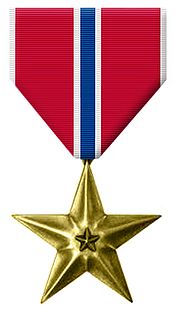Bronze Star Medal (USA)
- (a) while engaged in an action against an enemy of the United States;
- (b) while engaged in military operations involving conflict with an opposing foreign force; or
- (c) while serving with friendly foreign forces engaged in an armed conflict against an opposing armed force in which the United States is not a belligerent party.
Officers from the other Uniformed Services of the United States are eligible to receive this award, as are foreign soldiers who have served with or alongside a service branch of the United States Armed Forces. Civilians serving with U.S. military forces in combat are also eligible for the award.
The acts of heroism are of a lesser degree than required for the award of the Silver Star. The acts of merit or acts of valor must be less than that required for the Legion of Merit but must nevertheless have been meritorious and accomplished with distinction. The Bronze Star Medal is awarded only to service members in combat zones who are receiving imminent danger pay. Effective 11 September 2001, the Meritorious Service Medal may also be bestowed in lieu of the Bronze Star Medal (without Combat "V" device) for meritorious achievement in a designated combat theater.
Obverse
The medal is a bronze star 1 1⁄2 inches (38 mm) in circumscribing diameter. In the center is a 3⁄16 inch (4.8 mm) diameter superimposed bronze star, the center line of all rays of both stars coinciding.
Reverse
The reverse bears the inscription "HEROIC OR MERITORIOUS ACHIEVEMENT" with a space for the name of the recipient to be engraved.
Ribbon
The suspension ribbon is 1 3⁄8 inches (35 mm) wide and consists of the following stripes: 1⁄32 inch (0.79 mm) white 67101; 9⁄16 inch (14 mm) scarlet 67111; 1⁄32 inch (0.79 mm) white; center stripe 1⁄8 inch (3.2 mm) ultramarine blue 67118; 1⁄32 inch (0.79 mm) white; 9⁄16 inch (14 mm) scarlet; and 1⁄32 inch (0.79 mm) white.
Mounting
The star hangs from its ribbon by a rectangular metal loop with rounded corners.
Authorized devices
The Bronze Star Medal with the "V" device to denote heroism is the fourth highest military decoration for valor. Although a service member may be cited for heroism in combat and be awarded more than one Bronze Star authorizing the "V" device, only one "V" may be worn on each suspension and service ribbon of the medal. The following ribbon devices must be specifically authorized in the award citation in order to be worn on the Bronze Star Medal, the criteria for and wear of the devices vary between the services:
- Oak leaf cluster – In the Army and Air Force, the oak leaf cluster is worn to denote additional awards.
- 5/16 inch star – In the Navy and Marine Corps and Coast Guard, the 5/16 inch star is worn to denote additional awards.
- "V" device – In the Army, the "V" is worn solely to denote "participation in acts of heroism involving conflict with an armed enemy."; in the Air Force, the "V" is worn to denote heroism in combat.
- Combat "V" – In the Navy and Marine Corps and Coast Guard, the "V" is worn to denote combat heroism or to recognize individuals who are "exposed to personal hazard during direct participation in combat operations".
Dates
The Bronze Star Medal was established by Executive Order 9419, 4 February 1944 (superseded by Executive Order 11046, 24 August 1962, as amended by Executive Order 13286, 28 February 2003).
Issued
There have been 5 Signals and C&E Branch recipients of the United States Bronze Star Medal. Please see Bronze Star Medal (USA) - Signals Recipients for a listing of the individuals.
